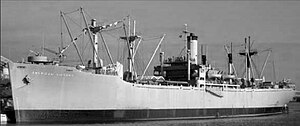SS Hagerstown Victory
 A VC2-S-AP2 type Victory ship
| |
| History | |
|---|---|
| Name | Hagerstown Victory |
| Namesake | City of Hagerstown, Maryland[1] |
| Owner | War Shipping Administration |
| Operator | Calmar Steamship Company |
| Builder | Bethlehem Shipbuilding Corporation |
| Laid down | December 19, 1944 |
| Launched | February 13, 1945 |
| Completed | March 13, 1945 |
| Identification | Hull 634 |
| Fate | Sold to private use, sank 1970 in typhoon. |
| General characteristics | |
| Class and type | VC2-S-AP3 Victory ship |
| Tonnage | 7612 GRT, 4,553 NRT |
| Displacement | 15,200 tons |
| Length | 455 ft (139 m) |
| Beam | 62 ft (19 m) |
| Draft | 28 ft (8.5 m) |
| Installed power | 8,500 shp (6,300 kW) |
| Propulsion | HP & LP turbines geared to a single 20.5-foot (6.2 m) propeller |
| Speed | 16.5 knots (30.6 km/h; 19.0 mph) |
| Boats & landing craft carried | 4 Lifeboats |
| Complement | 62 Merchant Marine and 28 U.S. Navy Armed Guards |
| Armament |
|
| Notes | [2] |
SS Hagerstown Victory was a
European Theater of Operations during 1945 and in the immediate post-war period repatriating U.S. troops. Hagerstown Victory was one of 97 cargo Victory ships converted to a troopship
.
Hagerstown Victory was one of many of the new 10,500-ton class ships known as Victory ships. Victory ships were designed to replace the earlier
U.S. Navy after the war. The Victory ship differed from a Liberty ship in that they were faster, longer, wider, taller, had a thinner stack set farther toward the superstructure and had a long raised forecastle
.
History
Construction and wartime operation
Hagerstown Victory was laid down on 19 December 1944, as a
3-inch (76 mm) gun and eight 20 mm cannons
for use against aircraft.
As a cargo ship, she delivered goods and war supplies to
U.S. Army Transportation Corps (USAT). Hagerstown Victory was crewed by U.S. Merchant Marines, protected by a contingent of U.S. Navy Armed Guards, and had a complement of USAT (Water Division) aboard for troop administration.[4]
She was able to transport up to 1,500 troops to and from Europe. As part of hot bunking. The cargo holds had mess halls and exercise places added.[5] After the war, in early 1946, she was used to take German and Italian POWs from the U.S. to Le Havre, France, and Antwerp, Belgium.[6][7][8][9]
Post-war use
Later in 1946, Hagerstown Victory was laid up in the
U.S. Marshals
and sold on 23 May 1969, to Windjammer Shipping Inc. of Wilmington. She was then renamed Windjammer Janeen.
In 1970, she was sold to Trans World Shipping Ltd. of
Formosa to the Philippines.[10] An SOS distress call brought three ships which were able to save 22 of the crew, but 9 crewmen were not found.[11][12]
References
- ^ Hagerstown, By Mary H. Rubin, page 1, photo of launching
- ^ Babcock & Wilcox (April 1944). "Victory Ships". Marine Engineering and Shipping Review.
- ^ APPENDIX B: VICTORY TROOPSHIP CONVERSIONS [1] Compiled from Roland W. Charles, Troopships of World War II (Washington, DC: The Army Transportation Association, 1947), Appendix E, pp. 356-357
- ^ United States War Department (1944). FM 55-105. United States Department of War. p. 12 Section 14, Allocated Vessels, Diagrams following p. 64.
- ^ Chapter 2 After ASTP, Across the Atlantic to England Under Siege, By Lester Segarnick
- ^ Hagerstown Daily Mail Newspaper Archives, May 07, 1973
- ^ army.mil Troopships of WW2, page 365
- ^ 69th infantry, Our Troopships
- ^ trailblazers of WWII, page 59
- ^ Mariners, The Website Of The Mariners Mailing List., Victory Ships
- ^ The Tennessean from Nashville, Tennessee · Page 9, November 21, 1970
- ^ The Morning News from Wilmington, Delaware · Page 2, November 23, 1970
